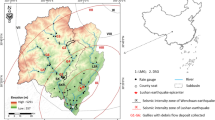Abstract
A large-scale debris flow occurred in Tongzilin Gully in Puge County, Sichuan Province in southwestern China from 4:00 a.m. to 4:30 a.m. on August 8, 2017. Although early warning measures were taken before the occurrence of the debris flow, the disaster resulted in 25 fatalities, the destruction of 71 houses, and economic losses amounting to 160 million RMB. This study aimed to analyze the movement characteristics of the debris flow, reveal the cause and mechanism of the catastrophe, and assist in avoiding similar future disasters. To this end, we calculated the debris flow density, velocity, and peak discharge and analyzed the dynamic characteristics of the debris flow. The distributions of regional precipitation and solid materials were also determined to analyze the formation conditions. Moreover, the debris flow blockage and disaster amplification mechanisms were investigated through field surveys, remote sensing images, and parameter calculation. The results show that the debris flow was a low-frequency turbulent event with a peak flow rate of once in a hundred years and an average velocity of 6.34 m/s. The debris flow developed under unique conditions, corresponding to the combined action of natural and anthropogenic factors. First, the low-frequency debris flow was initiated by antecedent drought and short-term heavy rainfall. The antecedent drought increased the amount of loose materials in the watershed (141.5 × 104 m3). The antecedent drought and short-term heavy rainfall nearly doubled the scale of the debris flow. Second, coarse particles blocked road culverts in the study area, leading to overflow and exacerbating the disaster. Consequently, the affected area and scale of the debris flow have been enlarged by 25% and by two times, respectively. The study findings provide deeper insight into the initiation and development mechanisms of debris flow disasters in mountainous areas, which may help improve the monitoring, early warning, and forecasting system.








Similar content being viewed by others
Data availability
The data used to support the findings of this study are available from the corresponding author upon request.
References
Alexander D (1992) On the causes of landslides: human activities, perception, and natural processes. Environ Geol Water Sci 20(3):165–179. https://doi.org/10.1007/BF01706160
Berti M, Simoni AM (2005) Experimental evidences and numerical modeling of debris flows initiated by channel runoff. Landslides 2(3):171–182. https://doi.org/10.1007/s10346-005-0062-4
Cannon SH, Gartner JE, Wilson RC, Bowers JC, Laber JL (2008) Storm rainfall conditions for floods and debris flows from recently burned areas in southwestern Colorado and southern California. Geomorphology 96(3–4):250–269. https://doi.org/10.1016/j.geomorph.2007.03.019
Chen H (2000) The geomorphological comparison of two debris flows and their triggering mechanisms. Bull Eng Geol Envirom 58(4):297–308. https://doi.org/10.1007/s100640000042
Chen JC, Lin CW, Wang LC (2009) Geomorphic characteristics of hillslope and channelized debris flows: a case study in the Shitou area of central Taiwan. J Mt Sci 03:266–273. https://doi.org/10.1007/s11629-009-0250-0
Chen NS, Chen M, Li J, He N, Deng MF, Tanoli JI, Cai M (2015) Effects of human activity on erosion, sedimentation and debris flow activity A case study of the Qionghai Lake watershed, southeastern Tibetan Plateau, China. Holocene 25:973–988. https://doi.org/10.1177/0959683615574893
Chen KT, Chen XQ, Hu GS, Kou YS, Huang YR, Shieh LCJ (2019) Dimensionless assessment method of landslide dam formation caused by tributary debris flow events. Geofluids 2019:1–14. https://doi.org/10.1155/2019/7083058
Cui P, Zhou GD, Zhu XH, Zhang JQ (2013) Scale amplification of natural debris flows caused by cascading landslide dam failures. Geomorphology 182(JAN.15):173–189. https://doi.org/10.1016/j.geomorph.2012.11.009
Fiorillo F, Guadagno F (2012) Long karst spring discharge time series and droughts occurrence in Southern Italy. Environ Earth Sci 65(8):2273–2283. https://doi.org/10.1007/s12665-011-1495-9
Gan BR, Liu XN, Yang XG, Wang XK, Zhou JW (2018) The impact of human activities on the occurrence of mountain flood hazards: lessons from the 17 August 2015 flash flood/debris flow event in Xuyong County, south-western China. Geomat. Nat. Hazards Ris 9(1):816–840. https://doi.org/10.1080/19475705.2018.1480539
George ST (2002) Suspension force and mechanism of debris flows. Bull Eng Geol Env 61(3):197–205. https://doi.org/10.1007/s10064-002-0156-3
Glade T, Crozier MJ, Smith P (2000) Applying probability determination to refine landslide-triggering rainfall thresholds using an empirical ‘Antecedent Daily Rainfall Model.’ Pure Appl Geophys 157(6–8):1059–1079. https://doi.org/10.1007/s000240050017
Hu GS, Tian SF, Chen NS, Liu M, Valenzuela MS (2019) An effectiveness evaluation method for debris flow control engineering for cascading hydropower stations along the Jinsha River, China. Eng Geol 266:105472. https://doi.org/10.1016/j.enggeo.2019.105472
Hungr O, Mcdougall S, Bovis M, Jakob M (2005) Entrainment of material by debris flows. Springer
Irmler R, Daut G, Mausbacher R (2006) A debris flow calendar derived from sediments of lake Lago di Braies (N. Italy). Geomorphology 77(1–2):69–78. https://doi.org/10.1016/j.geomorph.2006.01.013
Iverson RM (1997) The physics of debris flows”. Rev Geophys 35(3):245–296. https://doi.org/10.1029/97RG00426
Johnson KA, Sitar NA (1990) Hydrologic conditions leading to debris-flow initiation. Can Geotech J 27(6):789–801. https://doi.org/10.1139/t90-092
Kang ZC, Li ZF, Ma AN (2004) Debris flows in China. Science, Beijing
McKee TB, Doesken NJ, Kleist J (1993) The relationship of drought frequency and duration to time scale. Am Meteorol Soc 1993:179–184
Napolitano E, Fusco F, Baum RL, Godt JW, Vita PD (2016) Effect of antecedent-hydrological conditions on rainfall triggering of debris flows in ash-fall pyroclastic mantled slopes of Campania (Southern Italy). Landslides 13(5):967–983. https://doi.org/10.1007/s10346-015-0647-5
Ni HY, Zheng WM, Ba LZL, RJ, (2010) Recent catastrophic debris flows in Luding county, SW China: geological hazards, rainfall analysis and dynamic characteristics. Nat Hazards 55(2):523–542. https://doi.org/10.1007/s11069-010-9545-2
Schneider H, Hoefer D, Irmler R, Daut G, Maeusbacher R (2010) Correlation between climate, man and debris flow event—a palynological approach. Geomorphology 120(1–2):48–55. https://doi.org/10.1016/j.geomorph.2009.09.014
Seiler RA, Hayes M, Bressan L (2002) Using the standardized precipitation index for flood risk monitoring. Int J Climatol 22(11):1365–1376. https://doi.org/10.1002/joc.799
Sheffield J, Wood EF (2006) Global Trends and variability in soil moisture and drought characteristics, 1950–2000, from observation-driven simulations of the terrestrial hydrologic cycle. J Clim 21(3):432–458. https://doi.org/10.1175/2007JCLI1822.1
Smadja J (1992) Studies of climatic and human impacts and their relationship on a mountain slope above Salme in the Himalayan Middle Mountains, Nepal. Mt Res Dev 12:1–28
Takahashi T (1991) Debris flow published for International Association for Hydraulic Research by A.A Balkema. Brookfield
Tang C, Zhu TJ, Li WL, Liang L (2009) Rainfall-triggered debris flows following the Wenchuan earthquake. Bull Eng Geol Environ 68(2):187–194. https://doi.org/10.1007/s10064-009-0201-6
Tang C, Rengers N, Asch TWJ, Yang YH (2011b) Triggering conditions and depositional characteristics of a disastrous debris flow event in Zhouqu City, Gansu Province, Northwestern China. Nat Hazards Earth Syst Sci 11:2903–2912. https://doi.org/10.5194/nhess-11-2903-2011
Tang C, Zhu TJ, Ding J, Xiao FF, Zhang J (2011a) Catastrophic debris flows triggered by a 14 August 2010 rainfall at the epicenter of the Wenchuan earthquake. Landslides 8(4):485–497
Tang C, Yang Y, Su Y, Ding J, Huang WJ (2011c) The disastrous 23 July 2009 debris flow in Xiangshui gully, Kangding county, Southwestern China. J Mt Sci 8(2):131–139. https://doi.org/10.1007/s11629-011-2098-3
Wang GL (2013) Lessons learned from protective measures associated with the 2010 Zhouqu debris flow disaster in China. Nat Hazards 69(3):1835–1847. https://doi.org/10.1007/s11069-013-0772-1
Wang L, Chang M, Dou X, Ma G, Yang C (2017) Analysis of river blocking induced by a debris flow. Geofluids 2017:741
Acknowledgements
This research is financially supported by the National Key Research and Development Program of China (Project No. 2018YFC1505202), the National Natural Science Foundation of China (Grant No. 41861134008), and the Second Tibetan Plateau Scientific Expedition and Research Program (STEP) (Grant No. 2019QZKK0902). Thanks are extended to Meishan Engineering Survey Institute of Geology and Mineral Resources for their support and help in the investigation (Youth Innovation Promotion Association of the Chinese Academy of Sciences, Grant No. 2020367).
Author information
Authors and Affiliations
Corresponding authors
Ethics declarations
Conflict of interest
The authors declare that they have no conflict of interest.
Additional information
Publisher's Note
Springer Nature remains neutral with regard to jurisdictional claims in published maps and institutional affiliations.
Rights and permissions
About this article
Cite this article
Zhong, Z., Chen, N., Hu, G. et al. Aggravation of debris flow disaster by extreme climate and engineering: a case study of the Tongzilin Gully, Southwestern Sichuan Province, China. Nat Hazards 109, 237–253 (2021). https://doi.org/10.1007/s11069-021-04834-2
Received:
Accepted:
Published:
Issue date:
DOI: https://doi.org/10.1007/s11069-021-04834-2




